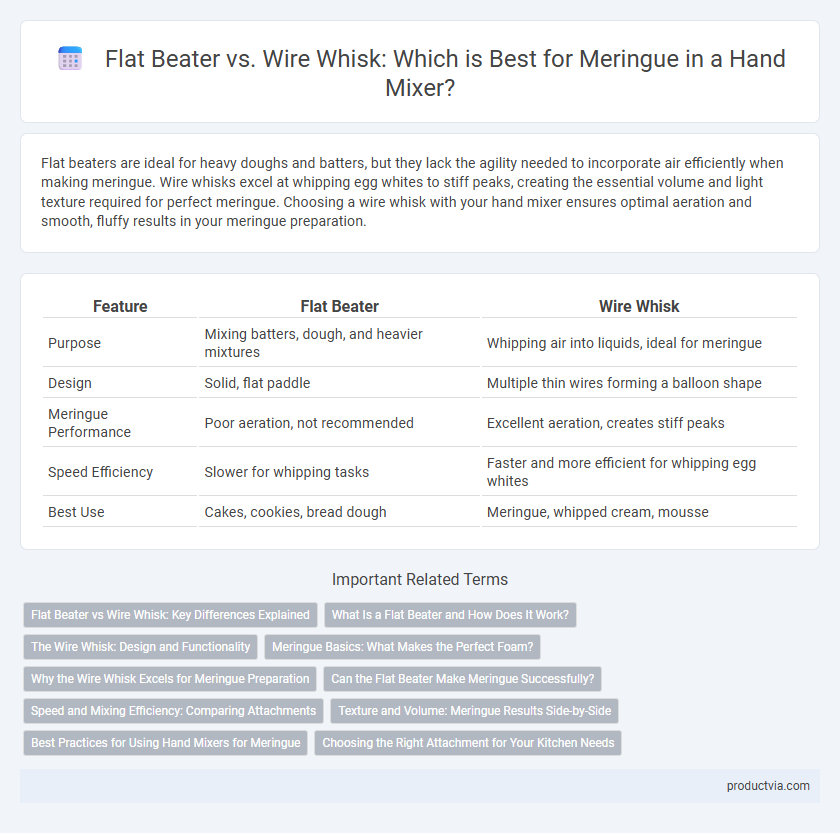Flat beaters are ideal for heavy doughs and batters, but they lack the agility needed to incorporate air efficiently when making meringue. Wire whisks excel at whipping egg whites to stiff peaks, creating the essential volume and light texture required for perfect meringue. Choosing a wire whisk with your hand mixer ensures optimal aeration and smooth, fluffy results in your meringue preparation.
Table of Comparison
| Feature | Flat Beater | Wire Whisk |
|---|---|---|
| Purpose | Mixing batters, dough, and heavier mixtures | Whipping air into liquids, ideal for meringue |
| Design | Solid, flat paddle | Multiple thin wires forming a balloon shape |
| Meringue Performance | Poor aeration, not recommended | Excellent aeration, creates stiff peaks |
| Speed Efficiency | Slower for whipping tasks | Faster and more efficient for whipping egg whites |
| Best Use | Cakes, cookies, bread dough | Meringue, whipped cream, mousse |
Flat Beater vs Wire Whisk: Key Differences Explained
The flat beater and wire whisk serve distinct functions in hand mixer use for meringue preparation. The wire whisk incorporates more air into egg whites, creating a light, fluffy meringue with increased volume. The flat beater, designed for mixing denser batters, is less effective at aerating and producing stiff peaks compared to the wire whisk.
What Is a Flat Beater and How Does It Work?
A flat beater, often made of metal or coated with non-stick material, is a common hand mixer attachment designed for mixing, beating, and blending medium-to-heavy mixtures like cookie dough and cake batter. Unlike wire whisks that incorporate air into mixtures, the flat beater efficiently combines ingredients without adding excessive air, making it unsuitable for creating meringue, which requires the aeration provided by a wire whisk. Its sturdy, paddle-shaped design ensures thorough mixing of dense ingredients while preventing over-aeration, crucial for achieving optimal dough or batter consistency.
The Wire Whisk: Design and Functionality
The wire whisk in a hand mixer features multiple thin, looped wires designed to aerate mixtures efficiently by incorporating air into egg whites for meringue. This design maximizes volume and creates a light, fluffy texture essential for stable, stiff peaks. Its functionality excels in whipping and blending tasks that require rapid air incorporation compared to the flat beater's denser, paddled structure.
Meringue Basics: What Makes the Perfect Foam?
The perfect meringue foam requires incorporating maximum air while maintaining stable protein structure, where a wire whisk excels by efficiently whipping egg whites to create voluminous, glossy peaks. Flat beaters tend to struggle with this task as their broader blades and slower movement can deflate the delicate egg white mixture, preventing proper foam formation. For optimal meringue results, using a hand mixer equipped with a wire whisk attachment ensures superior aeration and consistent peak development essential for perfect foam.
Why the Wire Whisk Excels for Meringue Preparation
The wire whisk excels for meringue preparation due to its multiple thin wires that incorporate maximum air into egg whites, achieving optimal volume and stability. Flat beaters lack the necessary structure to aerate effectively, resulting in denser mixtures unsuitable for light, fluffy meringues. Using a wire whisk with a hand mixer ensures quicker, more consistent peaks essential for perfect meringue texture.
Can the Flat Beater Make Meringue Successfully?
The flat beater in a hand mixer is not ideal for making meringue because it lacks the ability to incorporate enough air into egg whites, which is essential for achieving stiff peaks. Wire whisks are specifically designed to aerate and increase volume, making them the preferred tool for successful meringue preparation. Using a wire whisk attachment ensures better texture and stability in meringue compared to the flat beater.
Speed and Mixing Efficiency: Comparing Attachments
Flat beaters provide moderate speed and are ideal for dense mixtures but lack the aeration efficiency required for meringue. Wire whisks excel in high-speed rotation, incorporating air quickly to achieve stiff peaks essential for meringue's texture. Choosing a wire whisk over a flat beater ensures optimal mixing efficiency and faster meringue formation with a hand mixer.
Texture and Volume: Meringue Results Side-by-Side
The wire whisk is ideal for meringue due to its ability to incorporate maximum air, resulting in a light, fluffy texture with increased volume. In contrast, the flat beater produces denser meringue with less lift, as it mixes rather than aerates egg whites. For optimal meringue texture and volume, the wire whisk attachment in a hand mixer is the superior choice.
Best Practices for Using Hand Mixers for Meringue
For achieving perfect meringue with a hand mixer, use the wire whisk attachment to incorporate maximum air, creating a light and fluffy texture. Avoid the flat beater, as it lacks the ability to aerate egg whites sufficiently for stiff peaks. Speed and consistency matter; start at low speed to combine ingredients, then gradually increase to high speed for optimal volume and stability.
Choosing the Right Attachment for Your Kitchen Needs
Choosing the right attachment for your hand mixer ensures optimal results in meringue preparation; a wire whisk is ideal for incorporating maximum air, producing light and fluffy peaks, while a flat beater is better suited for dense mixtures and general mixing. Wire whisks create superior volume and stability in egg whites, making them essential for meringue, whereas flat beaters provide consistent mixing but lack the whisk's aeration capability. Selecting between these attachments enhances your kitchen efficiency by matching the tool to the texture and technique required.
Flat beater vs Wire whisk for meringue in hand mixer use Infographic

 productvia.com
productvia.com